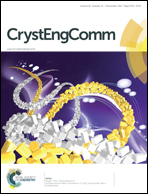Crystallization mechanism analysis of noncrystalline Ni–P nanoparticles through XRD, HRTEM and XAFS
Abstract
The crystallization behavior of noncrystalline Ni–P nanoparticles prepared by a liquid-phase pulsed-discharge method was studied through XRD, HRTEM, and X-ray absorption fine structure (XAFS) spectra from both Ni K-edge and P K-edge. A competitive growth between Ni3P and Ni crystalline phases was found. The main phases within the particles are crystalline Ni3P and Ni, while the metastable phase Ni5(P, Ni)2 is presented as a coated shell outside the particles. The appearance of feature D in the P K-edge XANES spectrum could be used as a characteristic for the formation of long-range ordered Ni3P. The standard deviation (ΔR/R) of the fitting P–Ni bond length from the theoretical value of a Ni3P crystal could be used to define the crystallization process. Although the nanoparticles were observed as XRD amorphous at 250 °C, their magnetic properties can be attributed to the formation of FCC-Ni clusters. A crystallization mechanism has been proposed to describe the crystallization process of the as-prepared noncrystalline Ni–P nanoparticles.



 Please wait while we load your content...
Please wait while we load your content...